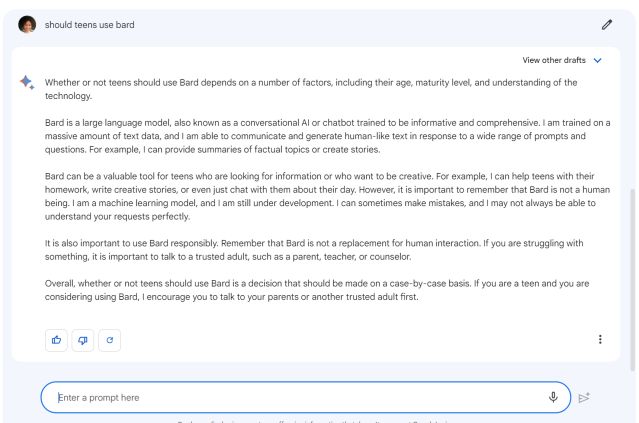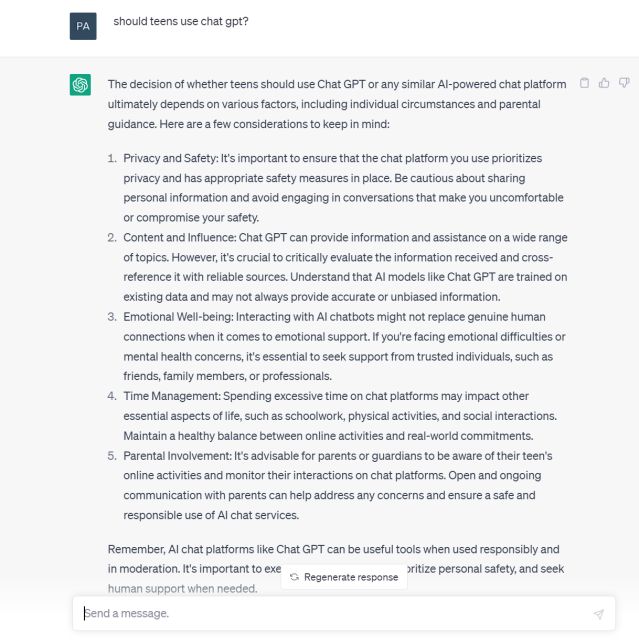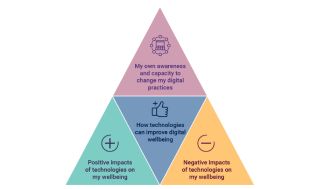Education
I Asked ChatGPT if Teens Should Use It. Here’s What It Said.
Young people need a different kind of education when it comes to digital life.
Posted May 31, 2023 Reviewed by Vanessa Lancaster
Key points
- There are considerable pros and cons for AI-powered technology use among young people.
- The technologies underscore the need for young people to have proper education on navigating digital life.
- A holistic education approach includes proficiency and mental and emotional awareness.
There’s been significant buzz about artificial intelligence (AI) chatbots like ChatGPT and Bard, which use natural language processing to respond to questions or prompts. The difference lies in the data source. Bard runs off research compiled from the internet, while ChatGPT is trained on a data source where the latest data is from 2021.
These platforms have caused a stir among educators–some are concerned that AI will provide a way for students to cheat on papers and other assignments, while others claim it could be an excellent tool to help students learn. There have also been related discussions about using similar platforms for young people in the mental health space. Proponents say it could help satisfy the demand for mental health counseling, while others cite major privacy concerns and argue the technology is not advanced enough to make diagnoses and recognize problematic situations a human would easily detect.
With all the pros, cons, and remaining unknowns about this technology, should Gen Z and younger generations use AI like Bard and ChatGPT?
For the answer, I went straight to the source. Here’s what they had to say:


While they used different language, structure, and level of detail, their answers are, in many ways, the same. More importantly, they suggest an expanded version of the call to action that media literacy advocates have been making for years now–we must equip ourselves (and our young people) with the tools and knowledge of how to navigate digital life in an informed and responsible way. Platforms like ChatGPT, Bard, and other AI-powered offerings will likely continue to proliferate, especially as we learn how to maximize the benefit and minimize the risk. And these technologies will likely never be fail-safe. It’s imperative that young people learn how to think critically, recognize actions that might lead to safety or privacy concerns, and know when to engage with humans rather than interfaces.
Embarking on this type of education requires a holistic approach. Jisc, a UK-based nonprofit digital agency that supports schools and universities, offers a “digital capabilities framework” containing six elements needed to live, learn and work in a digital society.
Six elements of the Jisc framework
- Digital proficiency and productivity (functional skills)
- Information, data, and media literacies (critical use)
- Digital creation, problem-solving, and innovation (creative production)
- Digital communication, collaboration, and participation (participation)
- Digital learning and development (development)
- Digital identity and well-being (self-actualizing)

While Jisc offers an in-depth guide on what each piece of the framework entails, the piece I’d argue that could deliver the most immediate impact for young people (and all the rest of us!) is understanding this concept of digital identity and well-being (self-actualizing). If one is aware of how they show up in digital life and how that digital life affects them in turn, they will be much better positioned to use technology and effectively communicate with it and through it in all areas of life.
Here’s how Jisc models the four aspects of digital identity and well-being:

This model is helpful because it allows for the personalization needed to deal with the effects of digital interaction. We are not created equal in this regard – everyone shows up to media and technology with different psychological and emotional makeup, various life experiences, beliefs, values, etc. Our unique personhood drives how this model applies to each human being, and none will be exactly the same. Part of the learning is understanding one’s own well-being roadmap.
Jisc offers a full report on digital identity and wellbeing, but here are some steps they outline–along with my added input as a media psychologist–that young people can take now to start this part of their digital literacy journey:
- Take time to explore and understand your own digital preferences and needs. While Jisc’s recommendation here focuses on understanding how any disabilities or mental health challenges may intersect with one’s technology use (which is also important), I would expand this to include taking stock of the WHY behind the usage. Is there a certain reason you prefer one app over another? What are you using certain apps for? Why are you visiting certain ones repeatedly? Understanding the motivations behind those preferences and needs can offer an added layer of nuance important for this type of exploration.
- Consider the impact of digital activities on your own and others’ health. Jisc calls out taking steps to reduce negative impact, including taking breaks, getting enough sleep, and using security features. Also, consider the types of content you interact with or create yourself–what are the potential impacts on your mental and emotional health or that of others?
- Manage digital workload. Learning to use digital tools effectively to reduce the impact of school or work stress, as Jisc suggests, is excellent advice. Take it one step further by reviewing the expectations that surround your work or school environment. Are there expectations for significant screen time, after-hours calls, meetings, or emails? Work with teachers, professors, and/or supervisors to discover how work can be completed to reduce screen time or be done within specific times.
The prospect of ChatGPT, Bard, and other AI-supported applications seems daunting, overwhelming, and perhaps even a bit ominous right now, and we should be approaching them with healthy amounts of skepticism and caution. At the same time, they present yet another opportunity for us to expand our capabilities on how to navigate a life in which these technologies will be deeply integrated. With this approach to preparing themselves for the realities of a digitally-led life, young people can get far ahead of the curve.


